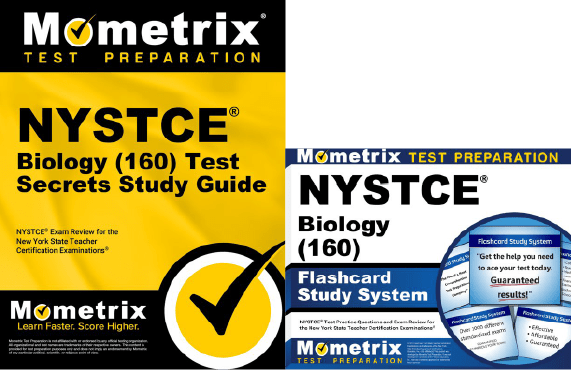If you need help studying for the NYSTCE Biology exam or just want some more information about what the test is like, you’ve come to the right place.
Click below to take a free NYSTCE Biology practice test!
What’s on the Exam?
There are 91 questions on the exam, which are grouped into seven competencies, and the time limit is 3 hours and 15 minutes.
The questions are split into two types:
90 questions
Selected-response questions require you to select the correct answer from a list of options. Multiple-choice questions are the most common example, but you may also see true-or-false questions and “matching” questions, which ask you to match terms or concepts with their definitions.
Constructed-Response (CR)
1 question
The constructed-response question requires you to write your answer instead of selecting from a list of choices. Your response to this question is generally expected to be at least a few sentences, but you’ll be given specific details and instructions before you take the test.
Let’s take a closer look at the competencies on the exam.
1. Structure and Function of Cells and Molecules
15 questions
- The characteristics of living things
- Primary functions and interactions of various cellular structures
- Processes of movement of matter
- The cell cycle
- Using and interpreting models of mitosis and meiosis
- The significance of meiosis and fertilization in increasing genetic diversity
- Basic chemistry and biochemistry
- Properties of water
- The structure and function of enzymes
- The engineering design process pertaining to cells and molecules
- Planning and carrying out investigations into cells and molecules
- Drawing inferences from texts and graphics
2. Structure and Function of Organisms
15 questions
- Characteristics and functions of viruses, protists, and prokaryotes
- The hierarchical organization and interactions of systems in plants and fungi
- Structures, functions, and disorders of the human reproductive system
- Reproductive technologies
- Human growth and development
- The link between disease and a failure of homeostasis
- Feedback mechanisms that maintain homeostasis
- Safe and proper use of scientific equipment and materials
3. Matter and Energy
15 questions
- Inputs, products, and processes of photosynthesis and cellular respiration
- The transfer of energy in living systems
- Aerobic and anaerobic respiration and fermentation
- ATP production through chemiosmosis
- Biochemical pathways involved in anabolism and catabolism
- Cycling of matter through the trophic levels in an ecosystem
- The transfer of chemical elements and molecules between abiotic and biotic components of ecosystems
4. Interdependent Relationships in Ecosystems
15 questions
- The biotic and abiotic factors that affect an ecosystem’s carrying capacity
- Factors that affect biodiversity, population sizes, and growth rates of species
- Interactions and dependences between organisms
- The influence of individual and group behaviors on chances of survival and reproduction
- The concepts of stability and resilience pertaining to ecosystems
- Solutions for reducing human impact on the environment
5. Inheritance and Variation of Traits
15 questions
- Structures and functions of DNA and RNA
- Causes and effects of mutations on DNA molecules
- Gene expression
- Processes that may produce heritable genetic variations
- Laws of classical genetics
- Genotypic and phenotypic frequencies
- Historical developments of scientific understanding regarding the patterns and mechanisms of inheritance
6. Evolution and the Unity and Diversity of Life
15 questions
- Empirical evidence that explains the origin of life, common ancestry, and biological evolution
- Interacting factors that may result in evolution
- Sources of variation of heritable traits in a population
- The principles of population genetics
- The Hardy-Weinberg principle
- Causes of speciation, species decline, and extinction
- Alternative patterns of evolution
- The changing of organisms over time
- Basic principles of taxonomy
- The unity and diversity of life
- The organization of organisms
7. Pedagogical Content Knowledge
1 question
- Assessing student readiness for a learning goal
- Designing culturally relevant instruction
- Designing appropriate and effective three-dimensional instruction
- Research-based strategies to guide all students to engage safely in biology concepts
- Promoting learning and growth for all students
How to Register
To get started with your registration, you’ll need to create an account on the NYSTCE website. You can then register for the exam and schedule a test date through your account.
Exam Scores
The test is scored using a scaled scoring method. Here’s how it works:
For every question you answer correctly, you get one point added to your raw score. At the end of the test, your final raw score will be converted to a scaled score. This scaled score will range somewhere between 400 and 600.
The reason your raw score is converted to a scaled score is because everyone who takes the test is given a slightly different set of questions. Since everyone has a different arrangement of questions, and because some questions are harder than others, converting your raw score to a scaled score ensures a more even playing field.
FAQs
How many questions are on the NYSTCE Biology exam?
The exam contain 91 questions.
What is the time limit for the NYSTCE Biology exam?
The exam is timed at 3 hours and 15 minutes.
What is the passing score for the NYSTCE Biology exam?
You’ll need to get a final scaled score of at least 520 to pass.
How much does the NYSTCE Biology exam cost?
The testing fee is $122.
NYSTCE and New York State Teacher Certification Examinations are trademarks of the New York State Education Department and Pearson Education, Inc. or its affiliate(s). This page was developed by Mometrix Test Preparation. It was not developed in connection with Pearson Education, Inc., nor was it reviewed, approved or endorsed by these agencies.



 NYSTCE Study Guide
NYSTCE Study Guide NYSTCE Flashcards
NYSTCE Flashcards